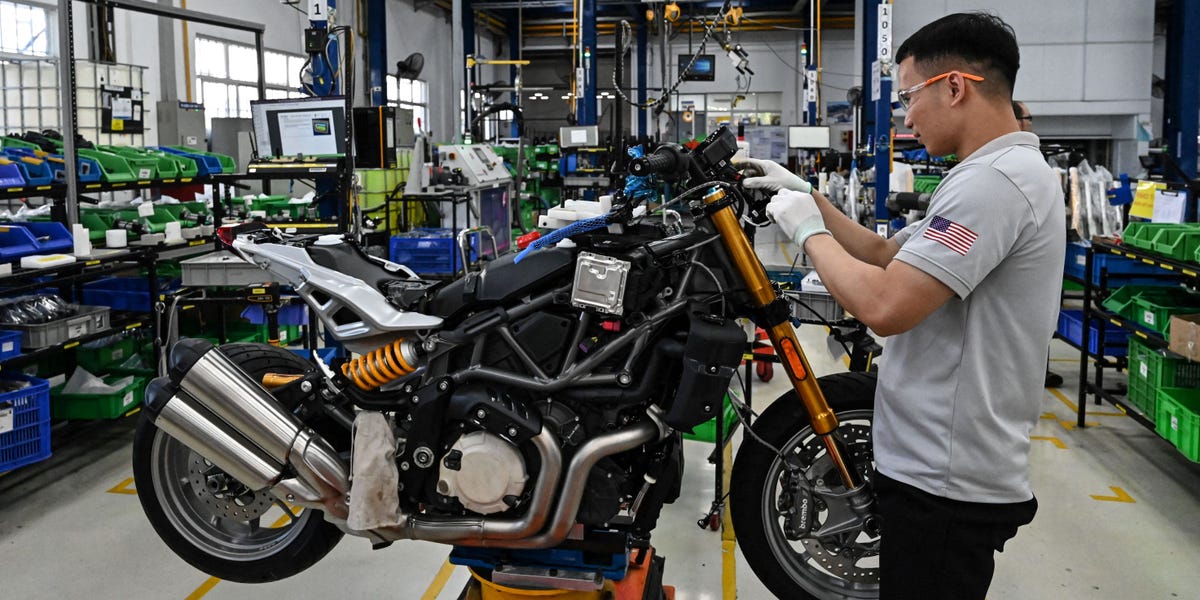- Supply chains are diversifying away from China, causing a shift in global-trade patterns.
- Analyses of trade data suggest Chinese manufacturers are assembling fewer end products at home.
- Instead, they’re shipping materials and intermediate products to Southeast Asia for final assembly.
Supply chains are shifting away from China — the world’s factory floor for the last four decades — toward other low-cost manufacturing hubs in Asia.
Even before supply chains got messed up during the COVID-19 pandemic, companies were already considering diversifying away from China after President Donald Trump launched a trade war against the country. Tensions between Washington and Beijing remain high under the Biden administration.
In recent years, companies including Apple and Mazda have been moving away from Chinese factories to neighboring Asian countries such as Vietnam and Bangladesh — but there’s more to that than meets the eye.
Data shows that while manufacturing activity for end products has been moving out of China, supply chains haven’t decoupled from the country.
Analyses of trade data suggest Chinese manufacturers are assembling fewer end products at home. Instead, they are shipping processing materials and intermediate products to Southeast Asia for final assembly.
“Companies are moving manufacturing processes to other countries, including parts of Asia and North America, to diversify their supply chains. In the process, they are demanding their suppliers diversify their supply chains as well,” Misha Govshteyn, the CEO of the Houston-based company MacroFab, a platform for electronics manufacturing, told Insider.
China’s importing fewer intermediate parts from Asia
Supply chains are part of an ecosystem. To produce in China, the raw materials or intermediate parts must come from somewhere in or outside the country.
Companies are moving their supply chains out of China. That means other countries in Asia — many of which supply commodities or intermediate products to China — have seen their exports to the country drop.
China’s share of exports from Asian countries has fallen from 22% in April 2021 to 18% in June 2023 based on their 12-month rolling averages, economists from Nomura Holdings wrote in a September 8 note titled “Is Asia slowly decoupling from China?” seen by Insider. The slowdown marks the biggest two-year decline in two decades, they added.
And it’s not just China’s domestic demand for imports that have fallen, according to Nomura’s analysis of Chinese customs data. China’s purchases of raw materials and intermediate products from most other Asian countries have fallen, too.
In particular, China’s share of processing-parts exports out of South Korea and Hong Kong fell by 2% over 26 months, from April 2021 through June 2023.
Nomura did not provide absolute numbers of the exports but said in its analysis that the decline in exports of processing materials reflects a shift in supply chains away from China.
“The broader trend of a fall in China’s share in Asia’s overall exports has continued for some time,” Sonal Varma, Nomura’s chief economist for India and Asia (excluding Japan), told Insider.
She added that China’s share in Asia exports has been falling over the past five years. The trend is shown in the graph below where the dotted line represents a general trendline.
China’s exports to Southeast Asia for product assembly have risen
Even though Asia may appear to be decoupling from China, at least one region on the continent is getting more tied up with the East Asian giant.
Southeast Asian trade with the East Asian giant has gotten more intertwined in a phenomenon called friendshoring — a practice where supply chains are focused on countries considered to be political or economic allies.
A report from HSBC released in September showed that more Chinese exports have been going to Southeast Asia than the US and Europe.
Exports from China to the 10-member Association of Southeast Asian Nations have reached nearly $600 billion a month based on 12-month moving averages compiled by the bank — surpassing the bloc’s shipments to the US and Europe since earlier in 2023.
This shift is partly because parts sourced from China are getting shipped to Southeast Asia for final assembly before getting reexported to their final consumer destinations — like the US — wrote Frederic Neumann, the chief Asia economist for HSBC, in the report seen by Insider.
HSBC’s observations echo findings made in an April report by Yukon Huang and Genevieve Slosberg, researchers at the Carnegie Asia Program.
They also found that China played a “behind-the-scene” role in supplying components and materials for other countries’ exports to the US, even though China’s share of total goods imported into America fell from 22% to 17% between 2017 and 2022.
“China may be exporting less to the United States directly, but it is now indirectly exporting more,” they wrote.
As Insider reported in April, even Chinese companies are moving their supply chains out of China to avoid risks.
Indeed, US companies had specifically asked Guangdong Vanward New Electric, China’s largest water-heater maker, to build factories outside the country “to continue co-operation with them,” Lu Yucong, the chair of Guangdong Vanward New Electric, told the Financial Times in April.
China will likely continue to play a big part of the world’s supply chains
Despite the rhetoric about de-risking away from China, the world’s second-largest economy is likely to continue playing an outsize role in global trade — even if indirectly.
In 2021, China accounted for about one-third of the world’s total manufacturing output, according to Carnegie’s Huang and Slosberg.
MaroFab’s Govshteyn echoed the sentiment: “China will always be a huge part of global trade,” he said.
Read the full article here





